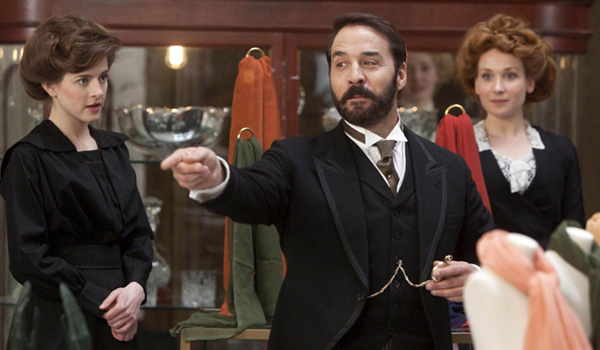
- Industry
The Real Mr. Selfridge
As ITV’s Mr. Selfridge shoots its fourth season it can be somewhat difficult for us, in the audience, to imagine Harry Selfridge as anyone but the buoyant, assertive personality that Jeremy Piven lends to him. HFPA member Meher Tatna investigates the real man behind the character.
Harry Selfridge wanted shopping to be a pleasure. And he wanted to keep customers in his store, which had everything they could possibly need, as long as possible. To that end, when he opened his eponymous store in the unfashionable west end of Oxford Street in London in 1909, designed by an architect to encompass five floors, a roof garden and three basements, it contained not only acres of sales space brightly lit and decorated with flower arrangements, but an elegant restaurant with an orchestra, a library, a silence room where weary customers could rest before resuming their shopping, a hairdresser, a manicurist, barber shop, first aid room, post office, reception rooms for French, German and American customers, and most importantly, ladies’ restrooms, something no store had ever had before. Selfridge & Co. became a London tourist attraction, right alongside Buckingham Palace.
A barrage of publicity preceded Opening Day, something, hitherto, unheard of in England. And though a minor disaster occurred with water sprinklers damaging the immaculately designed store windows, nevertheless thousands of customers came through the doors to marvel, shop or simply stare.
Harry treated his staff exceptionally well, paying them more than his competition; training them well and making them feel part of his enterprise. He was on the floor every single day, greeting customers, talking to staff and checking out how the merchandise was selling. It’s not common knowledge but he was the one who came up with the slogan ‘The customer is always right.’
Harry Gordon Selfridge started in poverty in the U.S. and became one of the richest men in the UK. A flamboyant impresario, he entered London society with his revolutionary vision of retail shopping by donating generously to the aristocracy’s pet charities and made valuable connections with them in order to lure them through his doors. Spectacularly successful in business, he nevertheless died in poverty, after blowing millions of dollars on gambling and women. His fascinating story is now a television show on PBS, Mr. Selfridge, with Jeremy Piven of Entourage in the title role, currently filming its fourth and final season.
The youngest of three sons, Harry was born in 1856 in Ripon, Wisconsin. When the American Civil War started, his father joined the army, abandoning his family when it ended and leaving his wife, Lois to raise the boys. When the two older ones tragically died, Harry and Lois moved to Jackson, Michigan where she struggled to raise him on $30 a month from her job as a school teacher. From a young age Harry started working at various odd jobs to keep them going – “cash boy and bundle wrapper,” then a bank job at age 14 – giving his mother all his earnings. Aside from her work ethic, what Lois instilled into her son was a sense of pride in his appearance, and the young Harry was a dapper dresser with clean fingernails, polished shoes and immaculate clothing, a habit he would insist his employees embrace decades later in his stores.
At 20 he got a job in a Chicago department store that would later become Marshall Field, which exists to this day and for which he worked for 25 years. Starting as a stock boy, his flair for showmanship led him eventually to the publicity department where he honed his ideas for making shopping an enjoyable experience for customers, who should be allowed to touch and try on merchandise.
When he was 34, Harry married local heiress Rosalie Buckingham, a well-traveled, well-educated young woman who was also an accomplished harpist. Lois not only went on the honeymoon with them, but lived with the couple until her death. Harry and Rose had four more children after the first one died. Though Harry loved Rose genuinely, he was not always faithful to her. She took his infidelities in stride and kept the marriage together.
The Milwaukee Journal of September 9, 1932 tells of how Harry got the idea of opening a department store in London when he visited one year as a tourist. “ … one day, after making some purchases in London shops and becoming disgruntled by the obsequious condescension of the shop assistants and by the unattractive ways of displaying merchandise, the idea for his London store was evolved.”
In 1906 he moved to London to set up Selfridges. “I was pretty much the wild and untamed man from the wild and untamed west when I came to London from Chicago more than a quarter of a century ago. And for me to introduce American business methods to Londoners was regarded as no less than an intrusion,” Harry told the Journal. He was 70 then and planning a $20,000 expansion to the store. At that time there were 22 branches across the UK with 15,000 employees, 5,000 in the London branch.
After Rose died in 1918 of the influenza, Harry continued his social life, lavishly entertaining show girls and society ladies. He lost millions of pounds in gambling, and when the Great Depression hit, he never recovered his fortune. He was forced out of Selfridges in 1941, and retired to a small flat with his eldest daughter. He died at age 89 in obscurity, completely destitute.
Meher Tatna
Jeremy Piven as Mr. Selfridge

